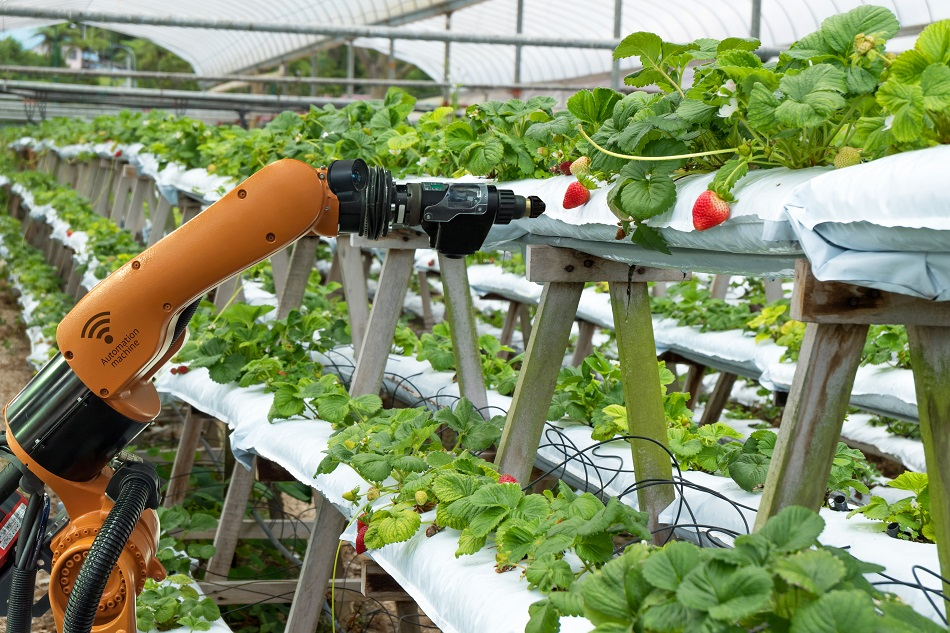
Image Credit: Zapp2Photo/Shutterstock.com
In recent years, robotics in the agricultural sector is the newly emerging technology.
The main reason behind the automation of farming processes is saving time and energy required for performing repetitive farming tasks and increasing productivity. This method of farming is known as precision agriculture or smart farming.
This revolution in agriculture transforms the ways in which food is produced. Smart farming entails a dramatic reduction in the volume of chemical inputs used.
Besides this, it also includes tillage, planting, harvesting, and sowing of seeds to meet the crop conditions across the field. It heavily relies on the latest technologies such as geospatial tools, satellite imagery, and more.
This approach can also identify critical factors that affect yield and determine intrinsic spatial variability. It also ensures that the variations in soil properties or crops are identified and mapped so that immediate measures can be taken.
Several autonomous guided robotic vehicles have been developed to carry out automatic weeding of agricultural fields. Precision agriculture mostly involves complex processes that could only be implemented using machines.
Precision agricultural robots not only combat the problems of weeding but also perform the complex processes of precision agriculture to improve the crop yield to a large extent.
How Do Precision Agricultural Robots Work?
The robot navigates the field and interprets the assigned task. It helps the farmers by blowing weeds, applying chemicals or harvesting the crops, and includes navigation systems to locate themselves.
It also employs cameras to pick green plants from the soil. The elimination of weeds is important as weed growth reduces the crop yield by more than 50%. Hence the robots are fitted with a precision spraying system that distributes herbicides onto the crops.
The utilization of sensors in this robotic system can also monitor the nutrient levels of plants and supply fertilizer as required.
What are the Main Advantages of Precision Agricultural Robots?
The major advantages of precision agricultural robots include the following:
- They are lightweight which eliminates soil compaction problems.
- Reduction of carbon dioxide emissions.
- Elimination of weeds.
- The precise application of chemicals can help to reduce soil damage and the pollution of watercourses
- Many of the robots can work to a 2 cm accuracy, meaning that every seed can be placed precisely and mapped.
- The use of robotics in the field helps to support multi-cropping practices that can aid natural pest control and improve biodiversity and yields.
- Scouting and crop care technologies can help optimize irrigation, increasing water efficiency.
The Commercial Aspect of Smart Farming
Globally, the precision agricultural robot market is experiencing an increase in investments due to the development of novel and technologically advanced robots.
Agricultural robots, or ‘agribots’, are gradually being deployed across the world to assist farmers and improve productivity by assisting in processes like harvesting and scouting.
Harvesting has been a mechanized process for a long time and this trend continues across the world. For the more delicate crops, hand-picking is still dominant. Octinion is developing a strawberry-picking robot.
Similarly, Augean Robotics have developed a lightweight, autonomous, rugged cart robot that can follow a person around and haul things for them. Many companies, such as Soyl, provide field mapping services that enable farmers to apply variable rate application of fertilizer. Some specific examples will now be outlined.
AutoProbe
The AutoProbe developed by AgRobotics is a precision agriculture robotic system that offers modern soil services to increase the cost savings and crop yield.
It also provides efficient, consistent, and accurate soil analysis compared to any other commercially available equipment. This automated system features a 6’ deep probe and collects samples in a shorter space of time than semiautomatic or manual sampling.
The key benefits of the AutoProbe include the following:
- Capable of sampling 150 acres within an hour
- Generates a quality sample every 45 seconds and sends it to cabs
- High yield
- Low cost
- Increased return
BoniRob
BoniRob, developed by Amazonen-Werke in association with Robert Bosch GmbH, Osnabrück University of Applied Sciences and other partners, is an autonomous field robot that is equipped with a global positioning system (GPS) and agro-sensors with spectral imaging technology.
The robot includes a quick-change device for use in sensors and a chassis with an individual wheel drive. This provides a wide range of options including track widths between 75 and 200 cm and adjustable ground clearance between 40 and 80 cm.
It can navigate independently and locate the GPS position of individual plants, before mapping and recording the locations. This system can automatically determine and monitor the growth states of plants continuously. The major advantages of BoniRob include the following:
- Aids plant breeders by automatically acquiring measured data of many plants
- Highly efficient
- Rapidly produces the output
- Eliminates weeds
- Selective application of fertilizer
This article was updated on 28th February, 2020
Disclaimer: The views expressed here are those of the author expressed in their private capacity and do not necessarily represent the views of AZoM.com Limited T/A AZoNetwork the owner and operator of this website. This disclaimer forms part of the Terms and conditions of use of this website.